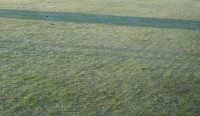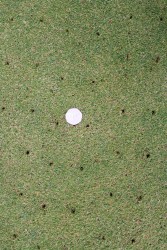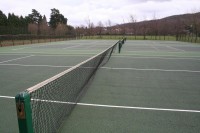November Tennis Diary
 I am sure there are plenty of groundsmen praying for some November rain to water their dried out playing surfaces. The recent long spell of dry weather during September and October has certainly taken its toll on many playing surfaces, with many having to water manually to keep there newly sown grass alive. However, once the rain does come it will be a case of making good use of the weather to carry out some much needed aeration work.
I am sure there are plenty of groundsmen praying for some November rain to water their dried out playing surfaces. The recent long spell of dry weather during September and October has certainly taken its toll on many playing surfaces, with many having to water manually to keep there newly sown grass alive. However, once the rain does come it will be a case of making good use of the weather to carry out some much needed aeration work.
Heavy morning dews are often prevalent this time of the year. It is important to remove the dew by brushing or swishing the surface to displace the water droplets, thus allowing the surface to dry quickly.
Keeping the sward dry is essential to prevent disease taking hold and spreading.
Some parts of the country have already had some heavy frosts and snow falls. Refrain from walking on frosted or snow covered greens.
Earthworm activity usually increases in November. Earthworms can survive in a wide range of conditions, but most activity is dependent on the quality of food available. Worms like plenty of Organic Matter (OM), therefore courts with a high thatch problem tend to encourage worm activity. Soil pH also affects where earthworms are found. In strongly acid or alkaline soils earthworms are rarely seen (pH less than 4.5 or greater than 8). The soil texture will also affect the number of earthworms found; they prefer clay soils and are less frequently found in sandy soils.
Worm activity inevitability leads to worm casts appearing on the playing surface. These worm casts can be very problematic, they tend to smear the surface, which in turn can affect surface water drainage capacity as well as providing a seed bed for weed germination.
Historically, earthworms have been controlled chemically, killing all earthworms in the turf. The most widely used chemical was chlordane, an organochloride, now banned due to it's wide ranging toxic effects and persistence in the environment. Currently there is only Carbendazim available for controlling worms and only works as a suppressant.
 Soils can become saturated after spells of prolonged rainfall. A saturated soil is a condition when the air spaces in the soil become predominantly filled with water. When soils remain in a saturated condition they can easily be damaged/de-structured by traffic or use of machinery. It is essential you keep off playing surfaces when saturated. A programme of aeration will aid surface drainage.
Soils can become saturated after spells of prolonged rainfall. A saturated soil is a condition when the air spaces in the soil become predominantly filled with water. When soils remain in a saturated condition they can easily be damaged/de-structured by traffic or use of machinery. It is essential you keep off playing surfaces when saturated. A programme of aeration will aid surface drainage.
It is essential you keep the surface open and free draining, aerating the playing surface with a sarel roller or some solid tines will be beneficial. However, only use machinery on the surface if you can operate without causing any smearing or damage.
There is still time to overseed and repair damaged grass areas. There may be a need to over sow recently repaired areas especially if the seed has not germinated very well. Rye grasses will still germinate in favourable temperatures in November. The use of germination sheets (covers) will help speed up the germination of newly sown seed.
The mowing height on the courts should be raised and maintained at a winter height of between 12-18mm. Mowing frequency will be dependant on a number of factors, grass growth, sward type, level or standard of facility, resources (staff & machinery) but, generally, it may only need mowing on a weekly/fortnightly basis to keep tidy during the winter months.
 Aeration / As required / Keep the surface open by the use of aerators, solid punch type aerators are considered the best method of aeration using tines of different depths and diameters. Ideally, you would want to try and achieve a depth between 100-200mm. A sarrel roller is often used to prick small holes in the surface down to a depth of 45mm.
Aeration / As required / Keep the surface open by the use of aerators, solid punch type aerators are considered the best method of aeration using tines of different depths and diameters. Ideally, you would want to try and achieve a depth between 100-200mm. A sarrel roller is often used to prick small holes in the surface down to a depth of 45mm.
Drainage / Weekly / Inspect drainage outfalls, channels and ditches. Ensure that they are working.
Diseases / Daily / Keep an eye on fungal disease attack, and use approved fungicides to treat infected areas. During November there is the likelihood of heavy dews forming on grass surfaces which often promotes outbreaks of disease.
A number of diseases are usually very active at this time of the year, namely red thread, fairy ring and fusarium.
Regular brushing or switching off the dew in the mornings will reduce the chance of fungal attack.
The application of wetting agents will aid the performance of fungicides.
Inspect tennis structures / As required. Label and store away all tennis furniture (posts, nets, seating and notice/score boards).
Litter/debris / Daily / Inspect and remove debris from playing surface litter or any wind blown tree debris, litter, twigs and leaves.
Leaf debris can be a problem during November. It is important to sweep and clear the leaves off the courts as an accumulation of wet leaves will damage the grass surface.
Machinery, repairs & maintenance / weekly / Inspect and clean machinery after use; service and repair damaged machinery.
Materials / Maintain material stocks and order any other consumables required.
Soil tests / Ideally once or twice a year, or as required. Soil sampling is an important part of Groundsmanship. The results will enable the manager to have a better understanding of the current status of his soil and turf. There are many tests that can be undertaken, but usually the main tests to consider are:
Particle Size Distribution (PSD) this will give you accurate information on the soil type and it's particle make up, enabling you to match up with appropriate top dressing materials and ensuring you are able to maintain a consistent hydraulic conductivity (drainage rate) of your soil profile.
Soil pH, it is important to keep the soil at a pH of 5.5-6.5, a suitable level for most grass plants.
Organic matter content, it is important to keep a balanced level of organic matter content in the soil profile.
 Nutrient Levels. Keeping a balance of N P K nutrients within the soil profile is essential for healthy plant growth.
Nutrient Levels. Keeping a balance of N P K nutrients within the soil profile is essential for healthy plant growth.
Once you have this information you will be in a better position to plan your season's feeding and maintenance programmes.
Artifical surfaces: Artificial tennis surfaces also need attention. Regular brushing is essential to keep them clean and free from contaminations. Sand filled/dressed carpet systems also require regular brushing to keep them clean and to redistribute sand infill materials.
Algae can often be a problem at this time of the year on artificial playing surfaces. Regular brushing and fungicide treatments may be required to reduce and remove algae growth on the courts. You should use approved chemical products when treating algae problems.
